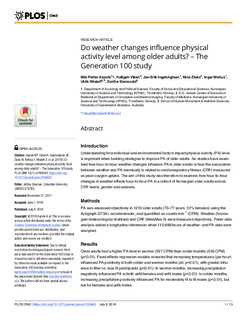| dc.contributor.author | Aspvik, Nils Petter | |
| dc.contributor.author | Viken, Hallgeir | |
| dc.contributor.author | Ingebrigtsen, Jan Erik | |
| dc.contributor.author | Zisko, Nina | |
| dc.contributor.author | Mehus, Ingar | |
| dc.contributor.author | Wisløff, Ulrik | |
| dc.contributor.author | Stensvold, Dorthe | |
| dc.date.accessioned | 2019-09-12T13:08:56Z | |
| dc.date.available | 2019-09-12T13:08:56Z | |
| dc.date.created | 2019-01-10T14:37:04Z | |
| dc.date.issued | 2018 | |
| dc.identifier.citation | PLOS ONE. 2018, 13 (7), 1-13. | nb_NO |
| dc.identifier.issn | 1932-6203 | |
| dc.identifier.uri | http://hdl.handle.net/11250/2616625 | |
| dc.description.abstract | Introduction
Understanding how individual and environmental factors impact physical activity (PA) level is important when building strategies to improve PA of older adults. No studies have examined how hour-to-hour weather changes influence PA in older adults or how the association between weather and PA eventually is related to cardiorespiratory fitness (CRF) measured as peak oxygen uptake. The aim of this study was therefore to examine how hour-to-hour changes in weather effects hour-to-hour PA in a cohort of Norwegian older adults across CRF levels, gender and seasons.
Methods
PA was assessed objectively in 1219 older adults (70–77 years, 51% females) using the Actigraph GT3X+ accelerometer, and quantified as counts·min-1 (CPM). Weather (Norwegian meteorological Institute) and CRF (MetaMax II) were measured objectively. Panel data analysis added a longitudinal dimension when 110.888 hours of weather- and PA data were analyzed.
Results
Older adults had a higher PA level in warmer (597 CPM) than colder months (556 CPM) (p<0.01). Fixed effects regression-models revealed that increasing temperatures (per hour) influenced PA positively in both colder and warmer months (all, p<0.01), with greater influence in fitter vs. less fit participants (p<0.01). In warmer months, increasing precipitation negatively influenced PA in both unfit females and unfit males (p<0.01). In colder months, increasing precipitation positively influenced PA for moderately fit to fit males (p<0.01), but not for females and unfit males.
Conclusion
To the best of our knowledge, this is the first study to examine the association between weather conditions and objectively-measured-PA among Norwegian older adults. Our findings demonstrates that unfit older adults will be less likely to participate in PA when the weather is unpleasant, compared to those highly fit. The data suggests that the impact of weather should not be ignored when planning public health strategies for increasing PA among older adults. | nb_NO |
| dc.language.iso | eng | nb_NO |
| dc.publisher | PLOS, Public Library of Science | nb_NO |
| dc.rights | Navngivelse 4.0 Internasjonal | * |
| dc.rights.uri | http://creativecommons.org/licenses/by/4.0/deed.no | * |
| dc.title | Do weather changes influence physical activity level among older adults? – The Generation 100 study | nb_NO |
| dc.type | Journal article | nb_NO |
| dc.type | Peer reviewed | nb_NO |
| dc.description.version | publishedVersion | nb_NO |
| dc.source.pagenumber | 1-13 | nb_NO |
| dc.source.volume | 13 | nb_NO |
| dc.source.journal | PLOS ONE | nb_NO |
| dc.source.issue | 7 | nb_NO |
| dc.identifier.doi | 10.1371/journal.pone.0199463 | |
| dc.identifier.cristin | 1654265 | |
| dc.description.localcode | Copyright: © 2018 Aspvik et al. This is an open access article distributed under the terms of the Creative Commons Attribution License, which permits unrestricted use, distribution, and reproduction in any medium, provided the original author and source are credited. | nb_NO |
| cristin.unitcode | 194,67,25,0 | |
| cristin.unitcode | 194,65,25,0 | |
| cristin.unitname | Institutt for sosiologi og statsvitenskap | |
| cristin.unitname | Institutt for sirkulasjon og bildediagnostikk | |
| cristin.ispublished | true | |
| cristin.fulltext | original | |
| cristin.qualitycode | 1 | |

